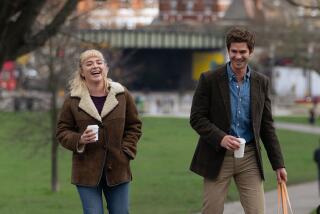Review: âI Was at Home, But ...â is a brilliant, elliptical German drama about family and loss
The centerpiece of âI Was at Home, But âŚ,â Angela Schanelecâs beautifully elusive and allusive new movie, is an argument between a woman and a man on a sidewalk. Itâs actually not much of an argument, since the woman, Astrid (Maren Eggert), is doing nearly all the talking. The man (Dane Komljen) is a filmmaker and presumably a friend, but that doesnât stop her from railing against the glaring artistic failures in his latest work: the hollowness of the acting, the misguided juxtaposition of reality and fiction. âItâs an experiment,â he says, nonplussed. It was âunbearably bad cinema,â she rebuts.
Granted, Astrid admits, she didnât stay to watch the whole thing. I recommend you do exactly the opposite with âI Was at Home, But âŚ,â which won the directing prize at last yearâs Berlin International Film Festival, and which deserves and rewards your close attention. This isnât an easy movie, which is to say its meanings and motives have no interest in announcing themselves. But neither is it especially difficult, and if you let it, Schanelecâs gentle, supple stream of images and their attendant associations will bear you dreamily aloft. The meanings, if not necessarily the motives, will follow.
That argument on the street is one of a few uncharacteristically explosive moments in a movie otherwise marked by its deeply expressive, wistful silences. It begins with a mysterious chain of images involving three animals, seemingly far from human civilization: A dog chases a scampering rabbit across a rock-strewn meadow, while a donkey wanders into an empty house. Violence and tenderness commingle: The rabbit, it seems, does not survive, but then Schanelec cuts to the strangely comforting image of the dog asleep on the floor while the donkey stands at attention, as though it were keeping watch.
Exactly how this animal prologue shapes what follows is, like much of the movie, open to interpretation. But thereâs something about that early evocation of tenderness between beings, of one creature protecting another, that seems to haunt the rest of this sad, splintered movie. Things shift to the human realm, and a story of sorts comes gradually into focus. Early on we learn that Astridâs teenage son, Phillip (Jakob Lassalle), has returned after an unexplained disappearance. While sheâs beyond relieved that heâs safe, itâs clear that the two of them â along with Phillipâs younger sister, Flo (Clara MĂśller) â arenât out of the figurative woods yet. They havenât been for a while, and are in fact experiencing the after-effects of profound grief.
The nature of that grief will eventually be made clear enough; Astrid briefly tells an acquaintance about the death of her husband two years ago, and in one exquisite flashback, set to a melancholy cover of David Bowieâs âLetâs Dance,â we catch a deeply moving glimpse of a family on the verge of rupture. But for the most part, Schanelec, a festival favorite whose work (including 2016âs âThe Dreamed Pathâ) has received little attention in the U.S., avoids easy exposition or explanation. She has structured the movie elliptically, as a kind of emotional and psychological puzzle, in which the usual connective tissue has been carefully excised, leaving behind only shards of tension and melancholy.
But she has also left behind clues, scattering them like invisible breadcrumbs in the margins of cinematographer Ivan Markovicâs beautifully lighted, immaculately framed images. One of these clues is the title, an explicit reference to âI Was Born, But âŚ,â Yasujiro Ozuâs 1932 silent masterpiece about two children whose view of their father irrevocably changes, for worse and for better. Another can be found in the extended scenes of Flo and her schoolmates rehearsing for a production of âHamletâ â specifically, lines from the famous âplay within a play,â in which real, tragic events are dramatized in hopes that they will coax forth recognition.
Curiouser and curiouser. Still another clue is the donkey, which, like most cinematic donkeys, canât help but exist in the shadow of Robert Bressonâs towering âAu Hasard Balthazar.â The association is underscored by Schanelecâs aesthetic choices throughout: the rigorous precision and duration of the individual shots, the quiet affectlessness of the performances and the particular sensitivity with which Schanelec photographs her actorsâ hands (and sometimes feet). Perhaps the most Bressonian quality of âI Was at Home, But âŚâ is that it sees its characters, for all their inner suffering, as existing within a state of grace, even when that grace doesnât seem apparent to them or us.
Astrid has long been the rock of her family, but Eggertâs stunning performance suggests that rock has sustained myriad invisible stress fractures. Her anger can make her ferociously lucid, sometimes comically so, as in an extended vignette in which she buys a used bicycle, then indignantly tries to return it when it breaks down. A scene in which she visits Phillipâs teachers, who are in the process of deciding his academic future, brilliantly captures her inner struggle between dignified restraint and total emotional disintegration.
Meanwhile, the kids hover around her, but they never seem to be merely slipping off to the sidelines. Flo and Phillip donât behave the way children often do in mainstream movies, with manufactured tears and histrionics. On the contrary, their sibling solidarity, sealed by the lovely image of Phillip carrying Flo on his back, is one of the movieâs most movingly understated gestures. When Astrid flies into an inconsolable rage, watch how patiently they surround her, with silent but persistent expressions of love that donât abate even when she rejects them. In these deeply affecting moments, you sense that this family will survive, even if not all or even most of their wounds can be healed.
âIâm sorry Iâm confronting you with a problem I canât solve,â Astrid tells Phillipâs teachers, one of whom (âTransitâsâ great Franz Rogowski) the movie will follow, inexplicably yet intuitively, into a poignant story of his own. But the fragmentary structure of âI Was at Home, But âŚâ feels all too appropriate for a story about how grief shatters and scrambles lifeâs narrative, forcing us to rewrite it in our own way. Can art offer any meaningful consolation? Itâs a question that may bring you back to that argument on the street, about the nature of authenticity versus artifice, and it may leave you feeling both baffled and moved by Schanelecâs own experiment. This is unbearably good cinema.
âI Was at Home, But ⌠â
(Not rated)
(In German with English subtitles)
Running time: 1 hour, 45 minutes
Playing: Laemmle Royal, West Los Angeles
More to Read
Only good movies
Get the Indie Focus newsletter, Mark Olsen's weekly guide to the world of cinema.
You may occasionally receive promotional content from the Los Angeles Times.











